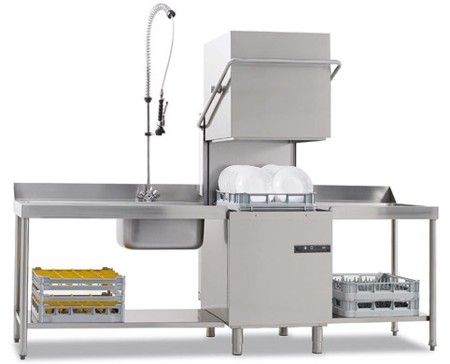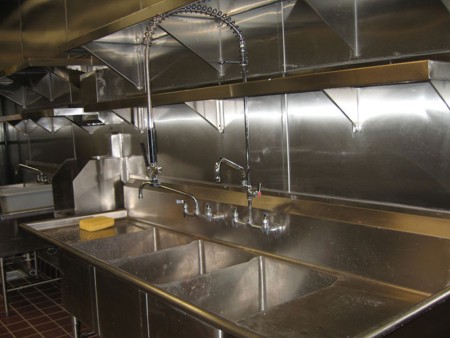In a restaurant, hotel or institutional kitchen, guess who the most important staff member is?
Yup. It’s the dish washer!
If the dish washer isn’t on top of things, there are no pots and pans for the cooks to cook with, no plates to serve the food on and no table utensils to eat it with. It’s that simple.
And, as lowly as the place of the dish washer may seem in the kitchen brigade hierarchy, he or she is actually the “point man” on the first line of defense against food borne illness.
Ware washing
That’s what folks in the foodservice industry call the collective job of washing the “back of house” dishes. That’s pots, pans, bowls, colanders and sieves, storage and serving containers, cutting boards, mixing spoons and paddles, ladles and spatulas… Everything used to prepare the food. (The dishwasher’s mandate also includes front of house serving plates, glassware and flatware, of course. And Professional cooks usually take care of their personal tools, especially their favourite knives.)
Large commercial kitchens usually have some kind of dish washing machine. These things look very different from your average home dish washer. First of all, they’re large. You can put a lot of dirty stuff in one, in a single load. And you can put big stuff in it, like 30 L stock pots, 20 L stand mixer bowls, big storage and serving containers, like the steel tureens and steam table pans (referred to as “hotel pans” in the biz) that you commonly see on buffet lines. They usually include in-feed and out-feed troughs, like the one pictured below.
These machines use powerful jets of extremely hot water in combination with industrial strength detergents and sanitizers to blast food debris and stains off of kitchen ware. And they do it fast. A single load will typically cycle through in about 90 seconds.
One of the key tasks of the restaurant dish washer, whether manual or automatic, is to ensure that all kitchen ware is not only clean but sanitized before reuse. That principle is basic to commercial kitchen food safety.
Hand washing
Here, we’re talking not about washing your hands, but about washing kitchen ware by hand.
Public Health regulations in most jurisdictions require a three-compartment protocol for washing back of house kitchen ware as well as front of house dishes, glassware and tableware.
You’re supposed to keep the first compartment full of hot, soapy water, the second is to rinse off the soap after scrubbing, and the third is for a solution of an approved kitchen sanitizer, again in hot water. In practice, you start by scraping off as much food debris as possible into a nearby garbage pail, and then rinse off any remaining loose material in the middle sink (which is usually fitted with a handy goose-necked sprayer house). Then you wash in the soapy water, rinse again in the middle sink and then immerse the object in the sanitizer compartment for at least 60 seconds. That procedure is designed to kill any germs and viruses that might have been present.
Now, you probably don’t go to these lengths in your kitchen at home. But you’re probably not serving the public, either. That’s a serious responsibility, and one that all professional kitchen operators take very seriously.
Nevertheless…
There are some key points to be taken from the commercial dish and ware washing rules and regs that will help you ensure that you serve your family safe, wholesome food at every meal.
The easy way to achieve pro-level food safety and sanitation standards in your home kitchen is to use your automatic dish washer. It not only offers a selection of washing cycles ranging from options such as “Pots and Pans” to “China/Gentle” and “Quick Rinse”. Another good thing about your home dish washer is that it washes with very hot water – hotter than you could stand to put your hands into. So hot, in fact, that it wouldn’t be safe to put your hands in it.
And on top of that, your dish washer almost certainly has a “sanitize” cycle. During that stage of the process, the machine heats the washing compartment to a temperature high enough to kill all harmful bugs – at least 80 C, or 180 F.
Unfortunately, size does matter!
But your larger items, such as Grandma’s monumental turkey platter, large mixing bowls and cutting boards probably won’t fin into your trusty dish washer. And don’t forget the fine bone china, the pots and pans with non-metal handles, the wooden-handled knives and other utensils, the plastic parts from your blender, food processor and other small appliances… The list goes on and on, really.
First of all, don’t rely on an old-fashioned dish rag. Your first choice should be a good, stiff plastic mesh “Molly” scrubber. Use a dish rag or a “J Cloth” style reusable cleaning cloth to get the tough gunk off. It’ll get into the creases and gullies and the places where the handle meets the blade – places where potentially-contaminating food residues may try to hide.
When washing any objects that come into contact with food, always use hot, soapy water. Use a good concentrated liquid detergent. We like the ones that are labelled “Antibacterial / for Hands and Dishes”. Rinse the soap off well with warm running water.
Allow the dishes to air/drip dry, bowls and other containers inverted so they drain thoroughly. If you wipe them with a dish towel, especially one that’s been used to dry dishes previously or to dry your hands, you’ll just be smearing fresh germs back onto your sparkling clean dishes! As when washing your hands, if you must towel them off, use a single-use cloth or paper towel and dispose of it properly afterwards.
Just a side note…
It’s always best to store your clean pots, pans, serving dishes and utensils in a closed cabinet or drawer, rather than in the open or on a wire rack. Or hanging them on a hook on the wall or from the ceiling.
They won’t just get dusty. Your kitchen is filled with a constantly-swirling mass of warm, moist air which often contains residues and vapours from cooking and cleaning activities as well as fats and oils thrown off from cooking foods, which will deposit themselves on your exposed kitchen ware as they cool and drop out of the air. Crazy? Nope. Just look at the stuff that’s been sitting on top of your fridge for the past few weeks or months. It’ll have a a thick, uniform coating house dust and other airborne gunk, stuck on by layer after layer of micro-deposited grease. Told ya.
Fortunately, most of the stuff on top of the fridge that can be put into the dish washer will come squeaky clean again after just one cycle. Other stuff will require a lot of hand scrubbing. Some may have to be thrown away.
So, practice common sense when cleaning your kitchen and dining ware. Store it safely and use it with respect. It’ll treat you right in return!
~ Maggie J.



